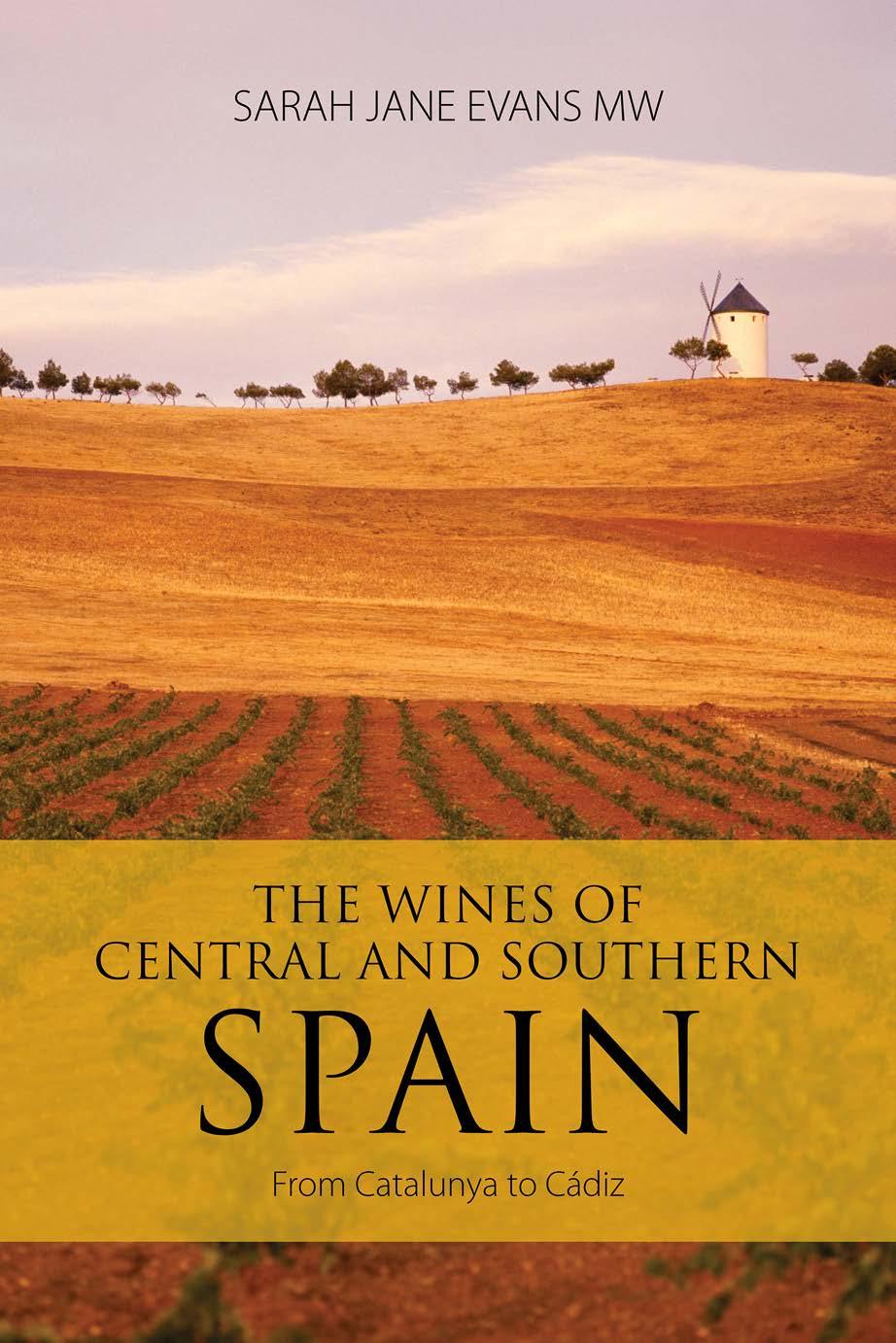

A MEDITERRANEAN NATION
It is equally unsurprising that Catalunya, with its long coastline, became such an important trading area. The glorious Roman theatre in Tarragona highlights the region’s historic importance and glamour. The commercial and tourist focus may have shifted to Barcelona, but what was once called ‘Tarraco’ was there first. Before the Romans there were the Iberians, the Phoenicians, the Greeks and the Carthaginians. Then Rome gave way to the Visigoths and the Moors, before eventually passing on to the succession of kingdoms from Barcelona to Aragón to France. The concept of Catalunya first appears in print at the beginning of the twelfth century. The region’s citizens have long had a clear sense of their identity, one which was first suppressed at the start of the
DO Alella
DO Conca de Barberà
DO Costers del Segre
ARAGÓN
Agramunt FRANCE
Raimat
Balaguer
Lleida
DO Empordà
DO Montsant
DO Penedès
ANDORRA
La Seu d’Urgell
Falset
Corbera d'Ebre
Manresa
Igualada
Valls
Reus
Granollers
Sant Sadurní d'Anoia Mataró
Vilafranca del Penedès
Sitges
Villanueva y Geltrú
Tarragona
VALENCIA Mediterranean
Map 2: Catalunya
DO Pla de Bages
DOQ Priorat, see detail map, p. 58
DO Tarragona
DO Terra Alta
Figueres
L’EscalaL’Escala
BegurBegur
BlanesBlanes
DO Catalunya
Shopping for food in Catalunya
The shop window of a good bakery is a seductive sight. Look out for the Pa de Pagès, a large, crusty loaf which has its own regional quality mark, or IGP, made for anointing with local olive oil. Enjoy it with IGP Queso de Garrotxa, the goat’s cheese from Girona with its grey-blue coat. There is an array of Catalan foods with a Protected Designation of Origin (PDO) to tempt the appetite – hazelnuts from Reus, pears from Lleida and, most significant of all, rice from the Ebro Valley. A seasonal trend is calçots which have an IGP from Valls in Penedès. These are leek-like spring onions, roasted, skinned and served with romesco sauce, made from almonds and red peppers. eighteenth century. National governments ever since have been trying to manage the Catalan question. What is clear, when we look at the wine business, particularly sparkling wine, as a microcosm of Catalunya, is that the Catalans had and have an outwardlooking, entrepreneurial character. They are creative, too, as illustrated by Antoni Gaudí’s Sagrada Família church in Barcelona, now almost complete nearly 150 years after construction began, and his other buildings in the city. In the world of wine there is a lovely series of buildings designed by modernist architects housing cooperatives, and of course the complex at Raventós Codorníu. But enough of history! Catalunya continues to delight and surprise, with an exceptional amount of innovation in wine within the last 25–30 years.
BETWEEN THE MOUNTAINS AND THE SEA
Catalunya is made up of four provinces: Lleida, Gerona, Tarragona and Barcelona. It is marked by three mountain ranges. To the north lie the Pyrenees, then, running parallel to the coast there are two ranges, the inland Prelitoral, which rises to 1,700 metres, and closer to the sea the Litoral at up to 760 metres. The most distinctive of the Prelitoral range is undoubtedly Montserrat, a wonderfully jagged mountain topped by a Benedictine monastery. Composed of a pinkish conglomerate it glows wonderfully in the sunset, and dominates the skyline for miles around. There’s a funicular railway if you do not want to walk up, but be warned, the site is a magnet for tourists. I understand why the citizens of the region’s capital, Barcelona, are up in arms about tourists – even if I am often one of those visitors.

are with local varieties. Her Pla de Tudela is a Picapoll Blanc. It’s a variety her father liked, though she says it was not popular. Fermented in tank and aged in concrete, it’s a fresh, saline wine. Anna’s a specialist in Garnacha, and her Negre, on granite soils, is a sunny, Mediterranean expression, grown so close to the sea.
Perelada www.perelada.com
Castillo Perelada is an impressive presence, with a modernist castle, a Michelinstarred restaurant (with a magnificent cheese trolley steered by Toni Gerez), a golfing hotel and, perhaps lowering the tone slightly, a neonlit casino. Founder Miguel Mateu is descended from the founder of the famous car company Hispano Suiza, and there’s an excellent museum to the history of the firm. There is also a striking, new winery, the first with LEED GOLD sustainability certification in Europe. The
The barrel cellar at Castillo Perelada’s impressive new winery
business is wideranging. On the one side there is Cava. Gran Claustro is a very likeable Pinot Noir and Chardonnay Gran Reserva. In the UK, Castillo Perelada Cava is a crunchy, refreshing, wellmade wine for the Waitrose supermarket chain. The still wines come from five estates across Empordà, from mountains to the Mediterranean (at the lovely Finca Garbet overlooking the sea amid the trees), with very different soils. The urbane Delfi Sanahuja is the winemaker. His wines are named after the estates. Aires de Garbet is a Mediterranean Garnacha on slate. Finca La Garriga is Chardonnay aged in acacia barrels and grown on sandy soils. The Ex Ex series is an everchanging set of microvinifications, numbered sequentially, from different varieties and different vineyards, showcasing different approaches to viticulture. In Priorat, Perelada coowns Casa Gran de Siurana with the Pérez family (of Mas Martinet). In Ronda, they are involved in the young project of La Melonera (see p. 256). In addition, Perelada has purchased the Chivite family business in Navarra and Viña Salceda in Rioja. Winemaker David González, formerly of Rioja’s Gómez Cruzado, is busy breathing new life into both of these historic brands.
Sota els Angels
www.sotaelsangels.com
Welshman Guy Jones started this winery in Baix Empordà with María Jesús Polanco in 2001. They have 8 hectares and work with Cariñena, Garnacha (red, white and grey), Merlot, Syrah, Viognier and Picapoll and farm using biodynamic methods. I asked Guy whether his wines were available in the UK. ‘No need, when we can sell it all locally,’ came the reply. So these are wines to look out for if you are visiting the area. Presencia is a Garnacha Blanca, full bodied and barrel aged, with a clear mineral impression. Meravelles is a lively expression of local whites: Garnacha Gris and Blanc, Picapoll and Cariñena Blanca. It is aged in ceramic to retain the floral expression. Amongst the reds is the Edición Extraordinaria Cariñena which spends a year in a used oak barrel. Only 250 bottles are made, so this definitely calls for a holiday in the region to shop for it.
On the radar
Vinyes dels Aspres (www.vinyesdelsaspres.cat), Vinyes d’Olivardots (www.olivardots.com), La Vinyeta (www.lavinyeta.es), Celler Martí Fabra (www.cellermartifabra.com).

Celler Credo’s VI-D-RE, made in a modern glass demijohn
thrillingly fresh. They are certified biodynamic and specialize in Xarel.lo (Miranius and Aloers are both varietal wines), but they also have a Xarel. lo Vermell (the rare, pinkskinned Xarel.lo) called Ambvivalent, and a Malvasía de Sitges named Mirabelles. In the continued search for purity and transparency, Ton has released VIDRE which has only been in touch with glass, and is closed with a glass stopper.
Celler Hospital de Sitges
www.cellerdelhospital.cat
This is the spiritual home of Malvasía de Sitges, and the actual home with a tiny vineyard. There’s a museum to the variety, and also a shop selling wines made from Malvasía.
Celler Pardas
www.cellerpardas.com
A fine example of the new generation working in Catalunya reviving local varieties. Ramón Parera Pardas (the winemaker) and Jordi Arnan Cabezas (the agronomist) founded the project in 1996 in the Alt
Penedès (Penedès Superior), determined to make wines only from their vineyards. The Can Comas property is some 65 hectares, bisected by the River Bitlles. They have a range of soils and aspects to work, with from alluvial to limestone terraces. I always make a detour to the stand at wine fairs for the Xarel.lo, which is a deliciously pure expression of the terroir. The Sumoll is also delightfully pure. They have international reds – the Cabernet Franc is particularly good. They have a sparkling which is two thirds Xarel.lo with one third Sumoll, and a second which is 100 per cent Sumoll. Isn’t it difficult to make a sparkling wine with a tannic red grape? Not at all, comes the reply, you just have to be careful about pressing the grapes gently. They chose to join Corpinnat rather than Clàssic Penedès. What inspired them to start traditional method sparkling wine in 2018? The reply is typically engaging and persuasive: ‘who could resist the temptation of rethinking and placing value on our calcareous territory through a sparkling wine prism?’ Indeed.
If you have a chance to taste don’t pass by. I say this because Ramón is the least showy of the chatty vignerons pouring wines around him at wine tastings, but the wines repay time and conversation with him. The wild boar emblem on the label symbolizes their closeness to their place, their origins. Dry farmed vines, no tilling, no synthetic products: ‘our way to work with the vineyards is therefore calm, personalized, tender and sensible’.
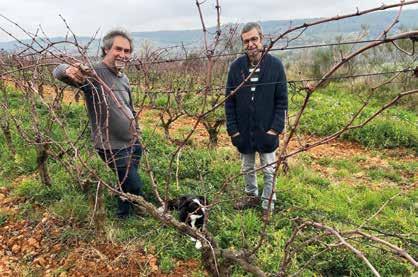
Celler Pardas: Jordi Arnan, Ramón Parera, Socks the dog and typically vigorous Sumoll vines
other DOs. Priorat is a DOQ, the highest qualification (Qualificada, the Catalan equivalent of Calificada), shared only by Rioja DOCa. Its logo is a ladder with angels, recalling the shepherd who had a vision of angels climbing a ladder into heaven. It was this that led to the establishment of the great Cistercian monastery of Scala Dei (meaning ‘stairway to heaven’).
La Bisbal de Falset Cabacés
La Viella Alta
La Viella Baixa
La Figuera
Els Guiamets Margelef
Cartoixa d’Escaladei Escaladei
El Lloar
El Molar Bellmunt del Proirat
Marçà El Masroig
Capçanes
La Serra d’Almos
Pradell de la Teixeta
La Torre de Fontaubella
La Vilella Alta
Torroja del Priorat
La Vilella Baixa
Map 3: Priorat and Montsant
Porrera
El Lloar
Gratallops
10 Masos de Falset
12 Solanes del Molar Montsant
DO Montsant DOQ Priorat
11 Bellmunt del Priorat
The person who led the Burgundian approach to classification has been Álvaro Palacios, and it’s a structure that he and his nephew Ricard Pérez Palacios have also enabled in Bierzo. In 2019 the DOQ launched Els Noms de la Terra, ‘the Names of the Land’. This was a bold step, something original for Spain. Priorat has been helped in the detailed work required by the fact that the region had been mapped for military reasons, and so every single parcel is clearly identified. Visit the DOQ website for an exhaustive listing of the parcels and maps of the soils.
What Priorat has now is a very clear pyramid of quality. At the top is Gran Vinya Classificada: single vineyard, very low yields (3,000 kilograms per hectare for reds and 4,000 for whites, 80 per cent of the vineyard over 35 years, five years of traceability). Three wines currently qualify: Álvaro Palacios’ L’Ermita, Mas Doix’ Tossal d’en Bou and Vall Llach Mas de la Rosa. There are more on the way. Below that is Vinya Classificada, which is slightly more generous. These are the two vineyard classifications.
Across all the wines in the pyramid there is a focus on Garnacha and Cariñena, and the fruit has to be estategrown or from longterm rental. Further, to be labelled vinyes velles, old vines, the vines have to be more than 75 years old (a wise choice; this is a long way from the definition of the Old Vine Registry and others, which has a 35year minimum). Below the Vinya Classificada comes Vi de Paratge, which is a wine from a single location (rather than a specific vineyard). Vi de Vila is grown within the boundaries of a village. Finally there is a general Priorat category. Vi de Vila is going to be interesting to watch. Priorat has 12 village subzones, these are: Bellmunt, El Lloar, Escaladei, Gratallops, La Morera de Montsant, La Villela Alta, La Vilella Baixa, Poboleda, Porrera, Torroja del Priorat, and the areas of Masos de Falset and Solanes del Molar. We talk about the differences in taste between Burgundy’s village wines, the question is: can we taste the Priorat villages? It should be possible over the coming years. Perhaps it is the human, winemaker influence that makes the difference: possibly it will be easier to identify Escaladei from Ricard Rofes’ wines at Scala Dei. Álvaro Palacios’ wines may make Gratallops easier to spot. Certainly Bellmunt in southern Priorat, where it is lower and warmer, and more open to the Mediterranean, does have a subtly different style. Burgundy has had centuries to reveal its differences to blind tasters. Priorat needs time too.
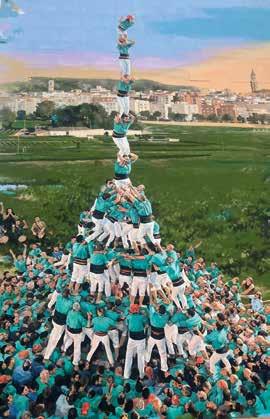
The slogan accompanying this mural of a castell in Vilafranca del Penedès, painted in 2024, references the economic crisis for grape growers: ‘Per un Penedès viu, cal un preu digne per al raïm i el vino’ – For a living Penedès, a decent price is needed for grapes and wine
vineyards, from a selection of altitudes and soils. They work with the local varieties, Xarel.lo, Garnacha in various forms, Sumoll and Malvasía, as well as Pinot Noir, Chardonnay, Merlot and Gewürztraminer, which were inherited from a previous generation, and are being grafted over. Cava dominates their production, though the still wines are very well worth exploring. Given the quality of their sparkling wines they would qualify as Corpinnat, however their main product is Cava brut, which is below the minimum age limit. Amongst the Cavas, I’d select Blanca Cusiné, a blend of Xarel.lo with Chardonnay and Pinot Noir, named after María Elena’s daughter, brisk and intense with 80 months ageing. There is also the Històric Gran Reserva, a memorial to the grandfather of this generation, and a rich, golden, 36 months aged wine, with a savoury

Marta Casas beside one of the fifth century BCE ovens found on the property for baking amphoras and other tools. She’s holding a wine made in amphora from estate clay
finish. Cuvée de Carol at 90 months ageing is a mature, persistent Cava, a blend of the classic varieties. A wine of real seriousness, with an impressive capacity to age, it is layered with citrus and brioche. They farm biodynamically and make their own preparations. Elaborador Integral.
Pere Ventura
www.pereventuragroup.com
Pere Ventura is a very wellpackaged, welldesigned brand. Pere is also a real person, an elegant businessman who launched his eponymous Cava estate in San Sadurní d’Anoia in 1992. The wines are particularly recognizable for their equally elegant branding, with diamond shaped patterns in the glass. In 2011 Pere purchased the Can Bas estate and from that he was able to launch his Cava de Paraje, the Can Bas Gran Reserva. It’s a blend of Macabeo and Xarel.lo, aged for 43 months, rich and structured with notes of honey and citrus, finishing fresh. In all, he makes 10 Cavas, white and rosado, mainly under the brand Tresor. At the Can Bas estate he has a range of single vineyard still wines under the DO Penedès from local and international varieties, as well as a Xarel.lo without sulphites. He also owns the Merum Priorati winery in Priorat.
MANCHUELA
Manchuela at a glance
DO: 2000
Vineyard: 13,431 hectares
Growers: 1,207
Wineries: 37
Production of DO wine: 24,543 hectolitres
Varieties
White: Macabeo (majority of whites), Albillo, Chardonnay, Sauvignon Blanc, Verdejo, Pardillo, Viognier, Moscatel de Grano Menudo, Garnacha Blanca, Moscatel de Alejandría, Tardana.
Red: Bobal (majority of reds), Cabernet Sauvignon, Cencibel (Tempranillo), Garnacha, Merlot, Monastrell, Moravia Dulce, Syrah, Garnacha Tintorera, Malbec, Moravia Agra, Mazuelo, Graciano, Rojal, Frasco (Tinto Velasco), Petit Verdot, Cabernet Franc, Pinot Noir, Touriga Nacional.
Selected producers
Altolandón www.altolandon.com
Rosalía Molina, the owner and winemaker, is a dynamo. Her wines are vinos de altura, grown on a high plateau at 1,100 metres, and she works across 200 hectares and a full range of international and local varieties planted in different soil types. Her wines are certified organic, and she uses clay amphoras and French oak barrels, with minimal intervention in the winery. As a result of the many varieties in the vineyards she has a hectic selection of wine. She certainly has Bobal, notably her very approachable Mil Historias Bobal. But she also has centenary Garnacha, Cabernet Franc, Tempranillo and Malbec as varietal reds, and Chardonnay and Moscatel de Grano Menudo for the whites. Alongside, there’s a blend of whites on skins: an orange wine made in tinaja, an orange in tinaja under flor and a pét nat. There is also a further surprise in the vineyard: Petit Manseng. Rosalía thought it might work in the vineyard at that altitude, and she’s right. Dulce Enero is a succulent, golden, acidic ice wine, harvested in January when the berries are frozen.
Finca Sandoval www.fincasandoval.com
Finca Sandoval earned its place in contemporary Spanish wine history for its founding father, Victor de la Serna. Victor, who died in 2024, was a person of many parts – journalist, sports writer, wine writer, gastronome – elegant in several languages and cofounder of the Grandes Pagos network. A person who could be guaranteed to comment on any event or situation, with wit and imagination. The wine critic turned vigneron with the launch of Finca Sandoval in 1998, working with the oenologist Rafael Orozco at a property that belonged to his wife’s family. No sensible person would have set up shop in a DO as obscure as Manchuela, least of all with the Bobal variety, however excellent the vines. But Victor did, and through his influence the winery continued to receive more attention than perhaps it deserved. The wines were not always stylistically consistent, and it was hard – for this consumer at least – to follow them from year to year.
Ultimately Victor sold the winery and the new owners brought in winemaker Javier Revert from his eponymous winery in Valencia to consult. Revert was a clever choice. His winery is only about an hour away, and his work with local varieties has quickly earned him an international reputation. Revert brought a certain discipline to the business, after assessing the Syrah and Touriga Nacional that Victor had planted, and local varieties

Javi Revert (right) at Finca Sandoval with owner Germán García-Cordero in the old vineyard of Moravia Agria which goes into the Salia blend
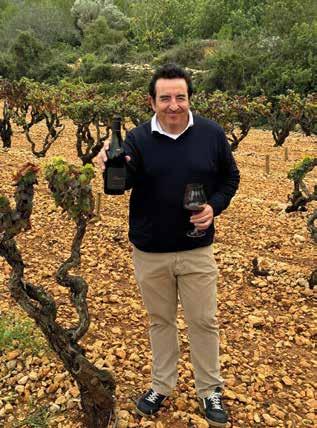
Pepe Mendoza enjoying his Fierroca amid the old Giró vines that go to make it
from overripe grapes. Naturally sweet, with a fine balance between ripe fruits and savoury notes, this could perhaps become a Fondillón when he ages it further. Pepe’s latest release is Fierroca which he regards as his first grand cru. Rightly so. It is a 100 per cent Giró from Marina Alta, from their Abargues property. The grapes come from three small terraces of 75yearold vines grown on ironrich soils. He says, ‘they have fewer anthocyanins, but more character, tannin and strength’. The wine was aged in new French oak for 10 months. This is the first. Look out for what comes next.
Riko
www.bodegasrikoxalo.com
Oscar Mestre’s family is established in Jalón (in Alicantino, Xaló) and runs a successful bulk wine business. Oscar has branched out with his
own wines under the family brand. His interest is in local varieties, minimal intervention and old vines. He has been seeking out old vineyards, and has also had advice from local experts including the wise and wellconnected Pepe Mendoza of Casa Agrícola. Renaix is a Moscatel; Insurrecte, also Moscatel, is fermented in 350litre tinajas and Trepadell is named after the rare white variety of the same name which was typically planted within Giró vineyards to add freshness to the final wine. He has three Girós: Colección Particular, Renaix and Oscar Mestre. These are exciting wines from a young producer. One to watch.
Sopla Levante
www.rodriguezdevera.com/sopla-levante
Pepe Rodríguez de Vera works in Alicante with wines named after the levante, east wind. It’s a partner to his wines from MontillaMoriles, named Sopla Poniente (see p. 272) after the west wind. Here he works with Bobal, Merseguera, Monastrell and other local varieties, bottling the wines in distinctive squat bottles, matching the wines from MontillaMoriles. As with Sopla Poniente he has a special interest in ageing under flor and in glass damajuanas, demijohns. A highlight here is the Matanilla white which is aged under flor for two years in Sherry barrels. The similarity of the wine’s name to ‘manzanilla’ is intended. Other wines of interest include an orange wine and a single vineyard Cariñena, designed to be a grand cru.
On the radar
Enrique Mendoza (www.bodegasmendoza.com). Based in Alfaz del Pi, not far from the sunset strip of the tourist coastline, with Monastrells Las Quebradas and Estrecho, and a Monastrell blend with international varieties called Santa Rosa.
Murviedro (www.murviedro.es). In Murviedro’s portfolio here (they also make wine in Cava, UtielRequena, Valencia and VT Vino de la Tierra de Castilla), the highlight is Finca El Serrano. It’s a single parcel Monastrell, deep and spicy, with notes of orange zest and cacao.
Masos (www.masosguadalest.com). Masos is a transformed lovely old masía or farmhouse which has become an elegant winery and events venue in the Guadalest valley. They have two red blends – Albor and Vidal Balaguer – a Monastrell rosado, and a wellmade Chardonnay, aged for 10 months in French oak.
There are two – a Palomino and a Sauvignon Blanc. They also produce classic reds, but the focus is on their 1986 palo cortado. Aged for more than 30 years in solera, it is typically pungent, with notes of mahogany furniture, nuts and spice.
MÁLAGA AND SIERRAS DE MÁLAGA: A TRADITION IN NEED OF PRESERVATION
Málaga has some truly exceptional wines, but so steep and winding are the roads you need a stout constitution to visit the mountain bodegas and vineyards. The DO takes in five separate zones of production: Montes de Málaga, Norte and Axarquía to the east and Manilva and Serranía de Ronda, to the west. Montes de Málaga is a striking area of mountain slopes and isolated patches of vineyard, with scattered white painted villages across the distant hills. This region is being rejuvenated particularly by Victoria Ordóñez. Axarquía is having a remarkable revival as a source of mountain wines, sweet and dry, from its precipitous vineyards. Serranía de Ronda is a more recent arrival, particularly driven by Friedrich Schatz and by Prince Alfonso de Hohenlohe who developed the glamour of the Marbella Club. Today it is recognized as a fine source of red wines in particular.
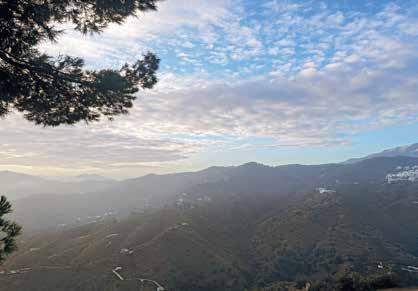
The villages of the Axarquía seen at dusk from Bodegas Bentomiz
Málaga
at a glance
The DO Málaga is for different categories of sweet wine and fortified wines only.
DO: 1933
Vineyard: 1,597 hectares (data shared with DO Sierras de Málaga)
Growers: 1,477 (data shared with DO Sierras de Málaga)
Wineries: 19
Production of DO wine: 11,106 hectolitres
Varieties
White: Pedro Ximénez, Doradilla, Lairen, Moscatel.
Red: (only in Sierras de Málaga).
Sierras de Málaga at a glance
Sierras de Málaga covers the same region as the main Málaga DO and is a particularly useful and flexible DO for producers wanting to make red wines and dry still white wines. In practice, the majority of Sierras de Málaga wines come from the Serranía de Ronda.
DO: 2001
Vineyard: 1,597 hectares (data shared with DO Málaga)
Growers: 1,477 (data shared with DO Málaga)
Wineries: 50
Production of DO wine: 10,603 hectolitres
Varieties
White: Chardonnay, Gewürztraminer, Riesling, Verdejo, Viognier, Moscatel, Pedro Ximénez, Macabeo, Sauvignon Blanc, Colombard, Garnacha Blanca, Malvasía Aromática, Montúa, Pardina, Perruno, Vermentino, Vijiriego Blanco.
Red: Romé, Cabernet Franc, Garnacha Tinta, Pinot Noir, Cabernet Sauvignon, Merlot, Syrah, Tempranillo, Graciano, Malbec, Monastrell, Tintilla, Petit Verdot, Blaufränkisch, Jaén Tinto.
The fruit of kings and cakes
Málaga has a proud history dating back to the eighth century BCE. The kings of Spain recognized the quality of the wines and licensed the first brotherhood of producers in 1608. By the end of the eighteenth century, Málaga wine was as famous as Sherry internationally. But producers
Gran Canaria at a glance
DO: 2006
Vineyard: 190 hectares
Growers: 294
Wineries: 43
Production of DO wine: 1,413 hectolitres
Varieties
White: Malvasía Volcánica, Gual, Marmajuelo (Bermejuela), Vijariego Blanco, Albillo, Moscatel de Alejandría.
Red: Listán Negro, Negramoll, Tintilla, Malvasía Rosada.
There are some heroically steep vineyards on the island, approaching 1,500 metres, where local varieties are grown and made into wine in nearby small family wineries using stainless steel, concrete and amphoras. Some of these wineries are tucked into caves in the hillsides. Sadly very little is exported. However, wineries such as Tamerán and Jable de Tao are putting Gran Canaria on the map with metropolitan drinkers internationally.
Selected producers
Agala www.bodegasbentayga.com
The island’s highest winery, literally above the clouds. The culdesac sign as you approach is a worry but you will find that the sign was right and the winery is indeed at a dead end. The long, low, shallow frontage of the building hides the fact that it is built into the hillside caves. Sandra Armas runs the winery that her father began. Her grandfather worked for the National Park, and her father now imports Honda vehicles to the island. With the help of an oenologist from Tenerife she has created a convincing series of wines, each labelled with the elevation of the vineyard. Agala 1318 is a white from the local Albillo Criollo, showing the typical ripe roundness of the local Albillo, with a chalky note and a punch of freshness to finish. The Tinto Joven 1050 is young, lively and likeable Listán Negro, made with carbonic maceration. More serious is the 1175, a Baboso Negro blend. It spends four months in oak, but has a wellbalanced freshness. Only the 1212 Crianza (which
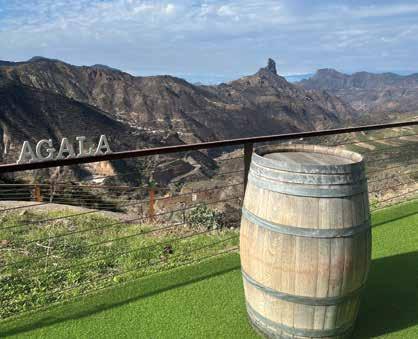
was from 2016) showed less well against the freshness of the younger wines. Sandra’s latest release is a white wine fermented with skins.
Bien de Altura
Instagram @biendealtura
Carmelo Peña was born in Gran Canaria, but was not born to winemaking. He started his career studying chemical engineering and was planning to open a restaurant. However, he was so taken by the world of wine that he studied for a Master’s in winemaking at the Rovira i Virgili University in Tarragona. There he met Luis Pedro Cándido da Silva, winemaker at Niepoort. They became friends and he went to the Douro to do the harvest. After that there followed a period gaining experience with all the best people, including Raúl Pérez, Pedro Parra and Marcelo Retamal. He is an islander who understands his role in the global wine market, and is focused on making international connections. He returned home in 2017 to make wine from Gran Canaria’s old vine material. It may seem that he has had plenty of luck, but his youth, energy and enthusiasm are a winning combination. Who wouldn’t want to help Carmelo on his path?
The view to the Atlantic from Agala winery, Gran Canaria’s highest (1,295 metres)
Conca del Riu Anoia, 110 Corpinnat, 105
Ximénez Spínola (Jerez), 234
YcodenDauteIsora (DO, Canary Islands), 283, 300–306
Yecla (DO, Murcia), 158, 174–175
Yuste (Sanlúcar de Barrameda), 238, 240
Zalema, 208, 209, 212, 213
